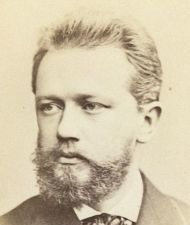The Nutcracker
Posted on 17th December 2019 at 10:53

On 18th December 1892, Tchaikovsky’s ballet The Nutcracker was premiered at the Imperial Mariinsky Theatre in Saint Petersburg, Russia.
Although the ballet is now popular throughout the world, the premiere was not well received, with popularity only coming after Tchaikovsky worked the music into a Suite.
Following the success of Sleeping Beauty, Tchaikovsky was looking for inspiration for his next ballet and a gift of a new Russian translation of E.T.A Hoffmann’s story Nussknacker und Mausekönig gave him a story he could work with.
It has been suggested that his love of the ballet Coppelia by Delibes, premiered in 1870, which was also based on two Hoffmann stories, Der Sandmann (The Sandman) and Die Puppe (The Doll) may have influenced his decision.
Following the success of Sleeping Beauty, Tchaikovsky was looking for inspiration for his next ballet and a gift of a new Russian translation of E.T.A Hoffmann’s story Nussknacker und Mausekönig gave him a story he could work with. It has been suggested that his love of the ballet Coppelia by Delibes, premiered in 1870, which was also based on two Hoffmann stories, Der Sandmann (The Sandman) and Die Puppe (The Doll) may have influenced his decision. Hoffmann’s Nussknacker und Mausekönig mixes reality and fantasy and there is some debate as to whether it was written as a children’s story or not due to the philosophical content and allusions unlikely to have been understood by children.

Tchaikovsky had collaborated with Marius Petipa on Sleeping Beauty, and so they set out to work together on The Nutcracker. Petipa took Hoffmann’s story and provided a scenario with detailed notes on action and dance plan with some suggestions for the music. However Petipa fell ill and passed the task to Lev Ivanov who had worked with him on Sleeping Beauty. Ivanov had previous devised the dances for Borodin’s Prince Igor and Rimsky-Korsakov’s Mlada.
The ballet is now a firm family favourite, and tells the story of a Christmas gathering where Drosselmeyer, a local councilman, toymaker and magician appears. He brings dancing dolls to entertain the children, then gives Clara and Fritz a toy for them: A wooden nutcracker which is carved in the shape of a man. Clara immediately takes a liking to it however Fritz breaks it, leaving Clara upset. Once everyone is in bed, Clara creeps downstairs to check on the broken Nutcracker and as the clock strikes midnight she sees Drosselmeyer on top of the Christmas tree which begins to grow as does the nutcracker. Mice appear, led by their King and begin to fight with an army of gingerbread soldiers.
The nutcracker leads the army of gingerbread soldiers and tin soldiers, as the Mouse King advances on the still-wounded nutcracker, Clara throws her slipper at him, distracting him long enough for the nutcracker to stab him.
As the mice retreat, in true fairy tale style, the nutcracker transforms into a handsome price, leading Clara to his Kingdom through a pine forest in the snow.
The second act begins in the Land of Sweets which is being ruled by the Sugar Plum Fairy in the Prince’s absence. When Clara and the Prince arrive, he tells how Clara saved him from the Mouse King and returned him to his human form. To celebrate his return and to honour Clara, a celebration is staged with dances from around the world, ending with a performance by the Sugar Plum Fairy.
A final dance is performed by all the sweets, before the Sugar Plum Fairy ushers Clara and the Prince down from their throne. He bows to her, she kisses Clara goodbye, and leads them to a reindeer drawn sleigh. It takes off as they wave goodbye to all the subjects who wave back.
For the full ballet, watch the Mariinsky Theatre’s performance here:
Having been influenced by Haydn’s Toy Symphony and Bernhard Romberg’s Kinder-Symphonie, Tchaikovsky includes some unusual instruments in the scoring of The Nutcracker including toy trumpet, rattle and bird calls. He also included a celeste. He wrote in a letter:
"I have discovered a new orchestral instrument in Paris, something between a small piano and a Glockenspeil, which a divinely beautiful tone… I want to ask you to order one of these instruments… have it sent direct to Petersburg; but no-one there must know about it. I am afraid that Rimsky-Korsakov or Glazunov might hear of it and make use of the new effect before I can."
After the premier of the ballet, Tchaikovsky wrote to his brother
"The staging … was splendid … even too splendid – one’s eyes grew tired of this luxuriance."
There were mixed reviews of the first performance, The St Petersburg Gazette stated:
"A more tedious work was never seen…"
However, the St Petersburg News-sheet declared
"Concerning the music of this ballet, it is hard to say which number is best, for everything from beginning to end is beautiful, melodious, original and individual."
It is this view that seems to resonate with audiences of the ballet and the suite today.
For a sneaky peek at how the Royal Ballet create the wonder and spectacle of The Nutcracker at The Royal Opera House, watch this video:
Tagged as: BALLET, CHRISTMAS MUSIC, COMPOSERS, MUSIC, MUSIC FOR CHRISTMAS, NUTCRACKER BALLET, TCHAIKOVSKY, THE NUTCRACKER
Share this post:




